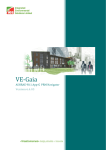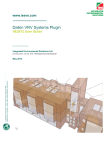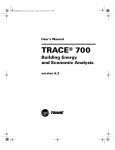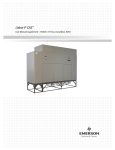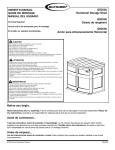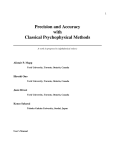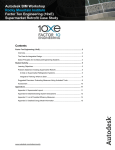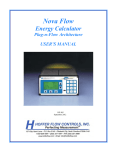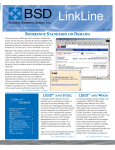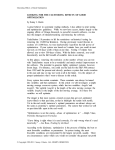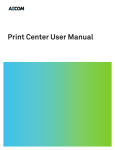Download VE-Gaia PRM Navigator - Integrated Environmental Solutions
Transcript
ASHRAE 90.1 Appendix G - PRM VE-Gaia PRM Navigator Performance Rating Method By: INTEGRATED ENVIRONMENTAL SOLUTIONS LIMITED Developers of the IES <Virtual Environment> Date: June 2010 A New Approach to Energy Modelling BOSTON, MA │ GLASGOW, SCOTLAND │ DUBLIN, IRELAND │ LONDON, ENGLAND │ MELBOURNE, AUSTRALIA │ SAN FRANCISCO, CA │ DUBAI, UAE Contents VE-Gaia: PRM Navigator Introduction.................................................................................................. 5 VE-Gaia: PRM Navigator – What makes it different?........................................................................... 5 VE-Gaia: ASHRAE 90.1 App-G PRM Navigator Structure ................................................................... 5 VE-Pro Modules to utilize with PRM Navigator................................................................................. 6 Preliminary Data Setup ........................................................................................................................ 8 Workflow concept ............................................................................................................................. 9 Site, Location and Climate................................................................................................................ 9 Prototype Data (ASHRAE Baseline) ............................................................................................... 10 Fossil Fuel Type ............................................................................................................................. 11 Update Profile Working Week Order............................................................................................... 11 Building Geometry .......................................................................................................................... 12 Settings ....................................................................................................................................... 12 Input Options............................................................................................................................... 16 Site Obstructions & Shading........................................................................................................... 19 Input Options............................................................................................................................... 19 Set Selected Zones to Obstructions............................................................................................ 19 Building Orientation ........................................................................................................................ 20 Room/Zone Group Assignment ...................................................................................................... 20 Solar Shading Calculation .............................................................................................................. 24 Envelope Thermo-Physical Properties ............................................................................................... 25 ASHRAE Baseline Constructions ................................................................................................... 25 Proposed Building Constructions.................................................................................................... 26 Improve Baseline ........................................................................................................................ 26 Custom Construction Type.......................................................................................................... 27 Surface Assignment........................................................................................................................ 27 Above Ground ............................................................................................................................. 27 Below Ground ............................................................................................................................. 27 Room/Zone Thermal Template Data .................................................................................................. 28 Space Classification ....................................................................................................................... 28 Room Conditions (set-points) ......................................................................................................... 28 Internal Heat Gains......................................................................................................................... 30 Equipment................................................................................................................................... 30 People......................................................................................................................................... 30 Lighting ....................................................................................................................................... 30 Page 2 Performance Rating Method Contents ASHRAE 62.1 Parameters ............................................................................................................. 32 Air Exchange .................................................................................................................................. 33 IAQ (Outside Air)......................................................................................................................... 33 Infiltration .................................................................................................................................... 34 Other End Uses .............................................................................................................................. 35 Exterior Lighting .......................................................................................................................... 35 Elevators ..................................................................................................................................... 36 Service Hot Water ....................................................................................................................... 37 HVAC Systems .................................................................................................................................. 38 Baseline System ............................................................................................................................. 38 Edit Current Baseline .................................................................................................................. 38 Assign Rooms ............................................................................................................................. 40 AHU System Parameters ............................................................................................................ 40 Proposed System ........................................................................................................................... 41 Improve Upon Baseline............................................................................................................... 41 Edit Current Proposed................................................................................................................. 41 OR Custom System .................................................................................................................... 41 Assign Rooms ............................................................................................................................. 41 AHU System Parameters ............................................................................................................ 41 System Schedules .......................................................................................................................... 41 Performance Curve Data ................................................................................................................ 42 Other Input Data................................................................................................................................. 43 Renewable Energy Systems........................................................................................................... 43 Utility Tariffs.................................................................................................................................... 44 Fossil Fuel Type ............................................................................................................................. 44 Generate Baseline.............................................................................................................................. 46 Generate the Baseline Model ......................................................................................................... 46 Sizing Runs ........................................................................................................................................ 48 Room Load Calculations................................................................................................................. 48 Assign Room Sizing Data ............................................................................................................... 49 System Load Calculations .............................................................................................................. 49 Assign System Sizing Data............................................................................................................. 49 Sizing Reports ................................................................................................................................ 50 Proposed..................................................................................................................................... 50 Baseline 0°.................................................................................................................................. 52 Baseline 90°................................................................................................................................ 52 Page 3 Performance Rating Method Contents Baseline 180°.............................................................................................................................. 52 Baseline 270°.............................................................................................................................. 52 Simulations......................................................................................................................................... 53 Proposed Model Simulation............................................................................................................ 53 0° Baseline Model Simulation ......................................................................................................... 53 Full PRM Simulation ....................................................................................................................... 53 Results ............................................................................................................................................... 54 BPRM Report ................................................................................................................................. 54 User Details ................................................................................................................................ 54 Data Tables 1.3 and 1.4.............................................................................................................. 55 Cost Savings Summary – Table 1.8.2(b) .................................................................................... 56 Energy Savings Summary – Table 1.8.2..................................................................................... 56 Baseline Costs – Table 1.8.1(b).................................................................................................. 57 Baseline Energy – Table 1.8.1 .................................................................................................... 57 Full Report .................................................................................................................................. 58 10 Minute Checklist ........................................................................................................................ 62 Proposed..................................................................................................................................... 62 Baseline 0°.................................................................................................................................. 65 Baseline 90°................................................................................................................................ 65 Baseline 180°.............................................................................................................................. 65 Baseline 270°.............................................................................................................................. 66 Display Selected Reports ............................................................................................................... 66 Page 4 Performance Rating Method VE-Gaia: ASHRAE 90.1 App-G PRM Navigator VE-Gaia: PRM Navigator Introduction VE-Gaia = Step-by -step analysis workflows - - VE-Gaia’s complete workflow environment is driven by “step-by-step” smart navigation that opens wide the power of IES analysis. A series of Navigators guide users through a range of tasks; from advanced modelling, to energy/carbon analysis, to LEED and Green Star credit interrogation and report creation VE-Gaia: PRM Navigator – What makes it different? The PRM Navigator establishes a ‘workflow concept’ to guide the user through the Performance Rating Method process. It particularly targets the USGBC LEED Energy & Atmosphere Credit 1 – Optimize Energy Performance energy modeling process, however it can be used in a number of other ways as well. For example, the following Green Rating Systems (but not limited to) that are used in different parts of the world also point to ASHRAE 90.1 Appendix G – PRM process as the requirement for energy credits as well: - LEED Canada (points to ASHRAE 90.1-2007) - Estidama (points to ASHRAE 90.1-2007) - LEED India (points to ASHRAE 90.1-2004*) *template data within the PRM navigator is based on 90.1-2007 version, so user will currently need to edit the input assumptions to run analysis for a different version of ASHRAE 90.1. What makes it different from other tools that are used for energy modeling? - It could be generally categorized as a wizard, but it’s a ‘smart navigator’: The PRM Navigator not only allows users to implement and manage the PRM process in a new way it also ‘navigates’ how the user can access the different VE-Pro modules required (see required module list below) to complete the different types of analysis involved in the PRM process in a streamlined manner. The user is also given real-time feedback along the way so they can compare how their design stacks up to the 90.1 requirements. - 5 in 1: All five models (proposed design + 4 baseline models) required for the PRM live in one file versus having to maintain the data across five different model files. - Input Data Once and Manage Edits effectively: The manner in which inputs are handled allows the user to input the data within the model, which influences the inputs in all five models. - Creating the Baseline Models: The required baseline models are generated from the proposed design filtered through the requirements of ASHRAE 90.1 Appendix G, at the stage in the process the user chooses to develop them. The user has two choices… VE-Gaia: ASHRAE 90.1 App-G PRM Navigator Structure The main objectives of the VE-Gaia PRM (Performance Rating Method) Navigator are to: 1. Manage the overall process, including inputs, edits and cycles of the PRM (ASHRAE 90.1 Appendix G) 2. Provide industry recognized defaults and input selection options (ASHRAE standards data as the basis) to assist the process Page 5 Performance Rating Method VE-Gaia: ASHRAE 90.1 App-G PRM Navigator A range of individual software modules and features are available within the VE-Pro suite which can be used to construct a detailed PRM model. The user needs to manually switch between modules and know at which point in the process a specific feature needs to be used. In summary it can be difficult to understand how each module and feature fits into the overall PRM workflow analysis process. The VE-Gaia PRM Navigator is a tool which brings all of the individual VE-Pro modules and features together in a single area and presents the user with step-by-step smart navigation and management of the PRM workflow and analysis process. The Navigator is driven through the successful execution of specific actions and commands which are activated by the user in a defined sequence. This smart navigation leads the user through the process of basic geometry creation, to constructions/thermal data assignment, and ultimately to the automatic generation of a full set of PRM compliant results which are presented in a format similar to the LEED EAc1 Letter Template. The Navigator also provides the user with predefined prototypical ASHARE data which can be used to populate the model with default baseline information. The main structure of the PRM Navigator workflow includes: 1. Preliminary Data setup 2. Envelope Thermo/Physical Properties 3. Room/Zone Thermal Template Data 4. HVAC systems 5. Other Input Data 6. Generate Baseline 7. Sizing runs 8. Simulations 9. Results The ASHRAE 90.1 App – G PRM Navigator functions as a series of hyperlinks that are accessed within the smart navigator tree structure that is located on the upper left side of the interface. The hyperlinks take the user to the relevant VE-Pro module and dialog box to complete the tasks associated with that topic. Note: that the user can increase the size of this area by dragging downward on the border between the VE-Gaia workflows area and the Rooms area. VE-Pro Modules to utilize with PRM Navigator The following list of VE-Pro modules are classified into two categories – required and beneficial. It is recommended that the user confirm which VE-Pro modules they have licenses for, so that they have the full capability of the PRM navigator available. Required: o ModelIT o Suncast o ApacheSim o ApacheLoads o ApacheHVAC Beneficial Based on what type of efficiency measures or HVAC system is being analyzed: Page 6 Performance Rating Method VE-Gaia: ASHRAE 90.1 App-G PRM Navigator o FlucsPro, LightPro, Radiance o Macroflo Figure 1 provides an over of the Virtual Environment software platform. The upper right portion of the diagram identifies the four tiers of the VE comprised of: - VE-Ware - VE-Toolkits - VE-Gaia - VE-Pro For additional information on the four levels go to “How and when should I integrate performance analysis for sustainable design?” The lower portion of Figure 1 identifies the different modules that a part of VE-Pro. For additional information on the different modules please go to - http://www.iesve.com/Software/VE-Pro Figure 1 - The Four Levels of the VE and VE-Pro Modules Page 7 Performance Rating Method VE-Gaia: ASHRAE 90.1 App-G PRM Navigator Preliminary Data Setup Figure 2 - Preliminary Data Setup Sub-Categories and Tasks A few things to note that are consistent across all the sub tasks for each of the nine main category areas with the navigator Figure 3 - Task Button Options Each task line will have up to three buttons shown to the right: - ? – provides a link to ‘help files’ directly related to that task line - Notes icon – when selected a ‘notes field’ will appear below, which allows the user to input specific notes related to that task for documentation purposes or to share with other team members - Check box – provides users the ability to select and ‘check’ that task as complete. This can be important for personal or team tracking on a large or complex project. Page 8 Performance Rating Method VE-Gaia: ASHRAE 90.1 App-G PRM Navigator Workflow concept The hyperlink serves a ‘help guide’ and takes the user to a more detailed description of the workflow concept for the navigator, similar to the information contained within this document. Site, Location and Climate The hyperlink for this action opens the ApLocate sub-program from which the user then specifies the global location of the building (Lat.>Lon.), external design conditions and simulation weather file. This process is driven by clicking on the ‘Selection Wizard...’ and following the necessary steps: Figure 4 - Location Selection There are four tabs associated with this dialog box: Location & Site Data – there are two options for selecting (Selection Wizard or Set Location Only) the climate file associated with the project. Page 9 Performance Rating Method VE-Gaia: ASHRAE 90.1 App-G PRM Navigator Design Weather Data – provides feedback on the climate selected and the ability to review and customize key parameters of the climate selected. This data will be used for the Sizing Runs. Simulation Weather Data – Reports the weather file that ApacheSim will be utilizing for simulation runs. The file is selected based on the choices within Location & Site Data/Selection Wizard, however the user can also change the selection within this tab to browse and select a different weather file. This data will be used for the annual thermal/energy simulations. Simulation Calendar – provides the ability to select and customize ‘a holiday template’ (days considered to be holidays which could trigger different building operation setting) based on the country and other parameters. Once the location is selected the climate file, which provides the input data for the hourly energy (8,760 hours) is determined. The VE actually runs the energy analysis on 6-minute time steps (as a default) versus hourly, so that the influence of thermal mass can be accounted for within the design. Prototype Data (ASHRAE Baseline) This command imports an ASHRAE 90.1 baseline data set which can then be used as a starting point for any PRM project. When the command is activated the software automatically imports a range of default ASHRAE data in a fully functional VE format. This allows a user to define the building based on the building type (for early stage analysis) or space type (for more detailed analysis): ASHRAE 90.1 Thermal Templates (Building Area Method or Space by Space Method) For the Building Area Method, default data is derived from: o ASHRAE 90.1 Internal Gains (Occupancy, Lighting, Equipment) For the Space by Space Method, default data is derived from: o ASHRAE 90.1 Lighting power densities o ASHRAE 62.1 Occupancy densities o Title 24 ACM Equipment power densities Both methods use o ASHRAE 90.1 Profiles/Schedules (from the User’s manual) o ASHRAE 62.1 Outdoor fresh air rates o ASHRAE 90.1 Envelope/Fabric Data (ASHRAE Climate Zone specific) o ASHRAE 90.1 Baseline Systems (1 to 8 +) All of these defaults are editable to suit your actual project through subsequent steps of the navigator. After the Navigator command has been activated the user must then select the “90_1_2007_IP” folder and subsequently select the associated VE .mit file. Page 10 Performance Rating Method VE-Gaia: ASHRAE 90.1 App-G PRM Navigator Figure 5 - Prototype Data Templates Fossil Fuel Type This command allows the user to select the appropriate fuel type per energy use which will be subsequently used in the automatic generation of PRM results reportage in the Results section of the Navigator. This step is only important if these energy end uses are served by fossil fuels. If they are served by electricity and assigned the appropriate fuel code, this step is not necessary. Figure 6 - Fossil Fuel Type Dialog Box Update Profile Working Week Order The hyperlink takes the user to the ‘Profile Weekly Pattern Editor’ which is used to dictate the daily operation of the building at a daily/weekly level. It allows the user to customize the operational days of their building to match the project requirements. For example, in the Middle East region the typical working week is Sun-Thu with Fri/Sat being the weekend. In the UK/US however the working week is Mon-Fri with Sat/Sun being the weekend. This dialog allows the user to customise the weekly operation of their building. An on/off filter is included which allows the weekday order re-shuffle/override to only be assigned to selected Profiles. The ‘All’ check-box allows a quick toggle to turn the entire list of profiles on/off. Page 11 Performance Rating Method VE-Gaia: ASHRAE 90.1 App-G PRM Navigator Figure 7 - Profile Weekly Pattern Editor Dialog Building Geometry Settings Locks Locks allow the user to snap the drawing tool to various items in the model view window such as model endpoint, midpoint, grid, etc. When creating model geometry it is useful to have the lock window open so you can switch different locks on and off depending on the particular modeling task you are trying perform. Page 12 Performance Rating Method VE-Gaia: ASHRAE 90.1 App-G PRM Navigator Figure 8 - Locks Dialog Box Grid Snapping to the grid when building model geometry ensures the creation of an accurate compact model which enhances accuracy and performance later in the analysis. This option allows the distance between grid points to be set - in both the x and y direction. Checking the grid box in the locks menu will force the drawing tool to snap to the grid. In general it is recommended to use a grid separation distance of 4 inches (0.1m). Figure 9 - Grid Settings dialog box Inner Volumes This option allows you to add or remove inner volumes from your model. Page 13 Performance Rating Method VE-Gaia: ASHRAE 90.1 App-G PRM Navigator Figure 10 - Inner Volumes Dialog Box Inner volumes are used to take account of the thickness of walls, ceilings and floors. The thickness of the walls will be defined later in the Apache Constructions Database. The thickness of the wall is represented in the model by a grey line which is offset into the room by the thickness of the wall. Inner volumes are only suitable for use in models with relatively simple geometry. Figure 11 - Plan view of model separated into 4 inner volumes Page 14 Performance Rating Method VE-Gaia: ASHRAE 90.1 App-G PRM Navigator Adjacency Separation Distance Figure 12 - Model Settings Dialog Box This command opens the model settings window. Adjacency separation distance defines the maximum distance that two surfaces can be away from each other, while still being recognised by the software as being adjacent. For example the two rooms in the image below on the right are 0.1m meter apart so the software would recognize them as being adjacent. Although in theory this is fine, in complex models it can cause errors to occur. It is recommended to always snap directly to the surface of the adjacent room as shown in figure below on the left. This can be done easily by using the ‘Model Endpoint’ lock. Figure 13 - Plan view example of room adjacencies Page 15 Performance Rating Method VE-Gaia: ASHRAE 90.1 App-G PRM Navigator Input Options Zoning (instructions) Zoning is of critical importance to the model. Too many zones and the model becomes over complex, too few and detail is lost. Although the main focus should be on capturing core functional spaces e.g. offices in commercial buildings or living rooms, bedrooms etc. in residential buildings - it is also necessary to capture the area/volume of other miscellaneous/ancillary spaces such as elevator shafts, toilets, stairs etc. The single most important aspect to note in relation to these space types is that they do not have to be represented exactly and individually to effectively convey the energy consumption of the building. In other words it is not necessary to model each and every space separately but instead zones can be outlined around each of these space types that capture all of a space type together. The zoning (thermal block) requirements outlined in ASHRAE 90.1 Appendix G (proposed model thermal zones and baseline model thermal zones to be the same) should also be kept in mind when creating the building geometry. The details presented should be followed closely in order to meet the requirements of the Performance Rating Method. As outlined in the concept document it is helpful that defined zones are broken-down as per the list of space types used in the prototype data: TABLE OF ROOM NAMES (from groups) Commercial Residential Data Center Bathroom Elevators Bedroom Gym Common circulation Gym (Changing / Showers) Corridor Kitchen Dining Lobby Elevators Office Kitchen Office ceiling void Living room Meeting Room Lobby Parking Parking Prayer room Services Retail (Catering) Store Retail (General) Void Services Stairs Stores Toilets Void Figure 14 - Table of Room Names These space types correspond exactly with the room thermal templates and provide some indication of Page 16 Performance Rating Method VE-Gaia: ASHRAE 90.1 App-G PRM Navigator what spaces should be grouped together. Manually Extrude Rooms/Zones Click the ‘draw extruded shape’ button and the ‘shape settings’ window will open. Set the height of the room and what plane the room sits on. You can name the room here or you can choose to name the room later by right clicking on it in the room list in the side bar. Draw the outline of a room by clicking on points in the model view window to define the room vertices. It is important to snap to the grid. Figure 15 - Shape Settings Dialog for drawing shapes Import DXF & Manually Extrude When importing a dxf it is important to select the correct scale factor. The drawing will appear in grey in the model view window and will sit behind the model. Use this to as a guide in which to trace your rooms over while snapping to the grid at all times. Figure 16 - Attach DXF file dialog Page 17 Performance Rating Method VE-Gaia: ASHRAE 90.1 App-G PRM Navigator Import GBXML (Revit, ArchiCAD etc) This hyperlink offers an alternative to manually building a model within the <VE> ModelIT module. It allows a .GBXML file to be imported from another CAD platform such as ArchiCAD or other. Note: IES has developed plug-ins (can be downloaded at www.iesve.com) for the following BIM platforms that facilitate translating the model into the VE platform in enhanced ways compared to straight GBXML: SketchUp and SketchUp Pro (version 6 & 7) Revit Architecture – 2009, 2010, 2011 Revit MEP – 2008, 2009, 2010, 2011 Model Settings The model setting window allows you to change the adjacency separation distance, verticalhorizontal element transition angle and perform model checks. Vertical-Horizontal Element Transition angle define at what angle a wall becomes a ceiling or a floor. By default, if a surface is at an angle less than 60o it is recognized by the software as a ceiling or floor. Figure 17 - Model Settings Dialog Box The model check option allows you to perform a check on the quality/integrity of the geometry in your model. Check the boxes for intersections and surfaces and click the check button. A text file will be created which will flag up any error in your model geometry. It is recommended to perform model check regularly throughout the model building process. It is usually far easier to fix a geometry problem soon after it occurs rather than at the end. Clicking the rebuild button refreshes all the adjacencies in the model. Page 18 Performance Rating Method VE-Gaia: ASHRAE 90.1 App-G PRM Navigator Site Obstructions & Shading Input Options Manually Extrude Rooms/Zones This command has no specific action and simply acts as a prompt giving the user the option of manually extruding zones from scratch. If this is the desired option then the standard ModelIT toolbar should be used to create zones by manually extruding in plan view. When all required zones have been created the Navigator check-box should be ticked confirming that the step has been completed Import DXF & Manually Extrude This command opens the ‘Import .dxf’ dialog and allows the user to place a .dxf as a trace layer within the ModelIT workspace. The user can then use the standard ModelIT commands to manually extrude zone geometry using the .dxf as a trace layer. Import GBXML (Revit, ArchiCAD etc) This command allows 3D .GBXML geometry to be imported directly from another CAD package such as Revit or ArchiCAD. Set Selected Zones to Obstructions All obstruction zones (i.e. non-thermal zones) should be selected before this hyperlink is selected. By subsequently clicking on the Navigator command the following dialog will appear: Figure 18 - Creating Obstructions Properties Dialog Box The dialog allows the room type to be changed from “Room” to a suitable type of shading type. There are three types of shading: Adjacent Building Topographical Shade Local Shade Page 19 Performance Rating Method VE-Gaia: ASHRAE 90.1 App-G PRM Navigator Building Orientation This option allows the orientation of the building to be set. The arrow points in the direction of north and adjusts when a value is entered on the input line (default position = pointing straight up). Figure 19 - Site Rotation Angle Dialog Box Room/Zone Group Assignment When the prototype data is imported into the working model, it contains a series of thermal room groups based on ASHRAE 90.1 ‘Building Area’ & ‘Space by Space’ methods. Page 20 Performance Rating Method VE-Gaia: ASHRAE 90.1 App-G PRM Navigator The prototype data also contains additional grouping schemes that may be relevant to the users project needs. The ‘Word Search Grouping’ tool is used to place rooms (thermal zones) into room groups. Figure 20 - Room Group Selection Rules Dialog Box The grouping schemes that exist in the project must be extracted into the room group creator, by selecting ‘extract’. Page 21 Performance Rating Method VE-Gaia: ASHRAE 90.1 App-G PRM Navigator Figure 21 - Import Room Grouping Scheme Dialog Box Depending on the naming convention used, common words are placed in the ‘Room Name Search Pattern’ dialog for each group. This name search uses the Perl regular expression syntax – see the user guide ‘PatternBasedGrouping.pdf’ for further information. In this example the rooms have been named using the convention detailed in the ‘room / zone names’ help section of the navigator and thus general terms like, office, retail, lobby, etc can be used to easily sort the rooms into their appropriate group. Page 22 Performance Rating Method VE-Gaia: ASHRAE 90.1 App-G PRM Navigator Figure 22 - Room Group Naming Example Clicking ‘Apply’ then places the appropriate rooms into their associated room groups. Figure 23 - VE Model Structure view of Room Groups If residential rooms exist in the model, this process needs to be repeated for the ‘Space types Page 23 Performance Rating Method VE-Gaia: ASHRAE 90.1 App-G PRM Navigator (Residential)’ room group. Solar Shading Calculation Clicking this hyperlink automatically opens the SunCast module and performs solar shading calculations. Solar shading calculations are performed hour by hour for the 15th day of each month of the year. These results will be fed into the Apache Dynamic Thermal Simulation as a simulation link. Figure 24 - Suncast Solar Shading Calculations status dialog box Page 24 Performance Rating Method Room/Zone Thermal Template Data Envelope Thermo-Physical Properties Figure 25 - Envelope Thermo-Physical Properties Sub-categories and Tasks This navigator category consists of a number of sub-categories and tasks designed to take users through the process of assigning ASHRAE baseline & proposed building envelope information. ASHRAE Baseline Constructions Step 1: The user must first select the Building Type. Step 2: Subsequently both Opaque & Fenestration construction category types must then be selected from the provided drop down boxes. By pushing the ‘ok’ button pre-defined construction materials will then be imported into the ApCdb construction data base manager, with default values corresponding to the relevant ASHARE Climate Zone requirements. Note: If a US climate zone location has been selected back in the ‘site, location & climate’ step the relevant ASHRAE 90.1 baseline construction will be automatically imported into the ApCdb construction data base manager’. Page 25 Performance Rating Method Room/Zone Thermal Template Data Figure 26 - Baseline Construction Type Selector Dialog Box Proposed Building Constructions Within this section the user can choose to assign proposed building constructions from one of two options. Improve Baseline The user can choose to select & edit any default ASHRAE 90.1 baseline construction type for use in the proposed model. Clicking the “Show Baseline” button will display a list of the baseline constructions, so you can assess how your proposed construction compares to the baseline requirements. Figure 27 - ASHRAE Assembly Wizard Dialog Box Improved baseline constructions for use in the proposed building can be imported into the ApCdb construction data base manager once manual edits have been made. Note that a copy will be made for the proposed building and the baseline construction itself will not be edited. Clicking the “Apply” Page 26 Performance Rating Method Room/Zone Thermal Template Data button will automatically assign your improved construction assembly to the entire proposed building. Custom Construction Type Alternatively the user can choose to create proposed building envelope constructions as per known project specifications. When choosing this option the user is taken straight to the ApCdb construction data base manager were they can create custom construction types for the proposed model from scratch. Figure 28 - Project Constructions Dialog Box Note: For future reference when using the VE. The line items in the dialog above that are highlighted in green mean that those external wall types (in this case) are being used in the model. Surface Assignment This command allows the user to assign proposed construction types to model surfaces. Note that baseline constructions will be automatically assigned to the baseline model once created (later step in the PRM Navigator Process). Above Ground Assign above ground proposed constructions Below Ground Assign below ground constructions. (As per ASHRAE 90.1 calculation method) Page 27 Performance Rating Method Room/Zone Thermal Template Data Room/Zone Thermal Template Data Figure 29 - Room/Zone Thermal Template Data - Sub-categories and Tasks This navigator stage consists of a number of sub steps that take the user through assigning thermal template information to the Proposed & baseline models. Space Classification This step assigns building thermal template information to the proposed model based on the selected thermal template scheme—i.e., the Building area method or Space by space method. This step is closely linked to the “Room/zone Group Assignment” step. Therefore, all spaces in the model must first be assigned to the appropriate groups in either the BLDG or SPACE grouping schemes. This can be done manually or with tools provided in the “Room/zone Group Assignment” step. Note that you must decide whether to use the Building Area Method OR the Space by Space Method, not a combination of the two. If you opt for the Space by Space method, then ensure that the room group assignment under the building area method is “NOT BLDG”. If you opt for the Building Area method, then ensure that the space by space room group assignment is “NOT SPACE” Room Conditions (set-points) Set design heating and cooling set point temperatures for ASHRAE load calculation and HVAC system sizing purposes. Matching HVAC system sizing with the set points used for system controls requires that the set point Page 28 Performance Rating Method Room/Zone Thermal Template Data entered here match those in the system heating and cooling profiles. To minimize unmet load hours, the set points subsequently entered in the System Schedules step must match these setpoints (these are not yet linked). If numerous thermal templates are in use for a particular project, and all zones will use the same heating and cooling set points, these set points can be simultaneously input via the Edit Group Attributes tool in the Apache Thermal view, rather than in the Building Template Manager. These set points can also be set for specific thermal templates. However, if they differ among zones in the project, this will not be accommodated by the System Schedules tool in the PRM workflow. Therefore, proper thermal performance for the zones with unique set points will necessitate creating a separate set of matching control profiles for zone-level heating or cooling airflows and/or terminal space conditioning equipment via the Apache Profiles Database Manager. The ApacheHVAC User Guide provides information regarding the control profiles referenced by the prototype baseline HVAC systems. While there are a number of options for heating and cooling profiles and custom profiles can also be created via the Apache Profile Database Manager, this is unnecessary in this context, as the assumption of continuous heating and cooling set points is appropriate to the room loads calculation. Note that the HVAC system equipment sizing is based upon design-day simulations with the actual proposed and baseline systems, including timed variation of set points, operating schedules, etc. As these set points will be used only for very preliminary (e.g., conceptual or early schematic design) and then system sizing, constant setpoints MUST be used. It is not necessary to include timed set points for nighttime setback, etc. as this is setup in a later step in the navigator. Figure 30 - Building Template Manager Page 29 Performance Rating Method Room/Zone Thermal Template Data Internal Heat Gains Set Proposed internal gains. Note: Equipment & People gains should remain the same in both the proposed & baseline models. Equipment Baseline & Proposed equipment loads should remain the same except in special cases. Editing the baseline column will apply changes to both models. Editing the proposed column will only edit the proposed model and a message will appear alerting the user that differences in equipment gains between the baseline and proposed must be justified with supporting documentation to the entity reviewing the energy model. People Baseline & Proposed equipment loads should remain the same. Editing the value in this dialog will apply the edit to both the proposed and baseline models. Lighting Set proposed lighting power densities for space types. The default values provided for the baseline model are in line with the values in ASHRAE 90.1-2007 Chapter 9 Lighting within: Table 9.5.1 Lighting Power Densities Using the Building Area Method Table 9.6.1 Lighting Power Densities Using the Space-by-Space Method Page 30 Performance Rating Method Room/Zone Thermal Template Data Figure 31 - Reduce Lighting Power - Proposed Manual Value Entry The dialog above shows the first way that the Lighting Power Density (LPD) can be input for the Proposed Design model through direct entry of a value on the far right column (LPD Proposed W/ft2) for each space type. Note that the LPD Baseline W/ft2 default value shown for each space or building type aligns with the ASHRAE 90.1-2007 Chapter 9 Lighting tables identified above. A second approach to establishing the LPD Proposed W/ft2 is shown in the figure below. The user can either directly enter a “% value” (1-100) in the input cell under ‘Please enter lighting reduction value’ or if targeting a 10% reduction can just select the ‘check box’ to the right of the input cell. By providing an input in either one of these ways the LPD Proposed will be derived by taking the LPD Baseline value and multiplying it by (100% - the lighting reduction %). Subsequent entries into the “% reduction” field will reduce the current proposed value by that percentage. If you desire to test alternate reductions compared to the baseline, then reset the proposed LPDs in the top section to match the Baseline, press OK, and then reopen the dialog and enter a new % reduction. Page 31 Performance Rating Method Room/Zone Thermal Template Data Figure 32 - Reduce Lighting Power Dialog - Custom Inputs ASHRAE 62.1 Parameters The hyperlink opens the ASHRAE 62.1 Parameters Editor (figure below), which is composed of three tabs and shows all Building and Space options available. In the upper left hand corner the user has the ability to select the check box for ‘show active space types’ to isolate just those utilized within the model. The three tabs include: Occupancy and Ventilation – provides the parameters for each line item that serve as the inputs into the ventilation calculations for the model. The user may select an alternate 62.1 occupancy category for each thermal template if they desire by picking from the drop down menu. The “Default Occupancy” column is not editable – this is the default occupancy level as per the ASHRAE 62.1 standard for each occupancy category. The “Design Occupancy” column can be edited if your proposed building has a different occupancy. Note that any previous edits to occupancy under the “Internal Heat Gains” will be reflected here. Edits here will also be reflected in the Internal Heat Gains/People window. Values for Ra and Rp are derived based on 62.1 Table 6-1. o Percentage increase in ventilation – on the lower right side of the dialog box the user can enter a custom value (1-100%) for the percentage increase in ventilation. After inputting a value and hitting ‘ok’ the percentage increase input is applied to all the line items included on this tab. This may be useful if the project is attempting to achieve LEED EQ Credit 2. Exhaust Requirements - provides the parameters for each line item that serve as the inputs into the ventilation calculations for the model. The user may select an alternate exhaust rate category if they desire by picking from the drop down menu. This will update the exhaust flow rates accordingly as per 62.1 Table 6-4. Edits may be applied to the “exhaust per unit” column if this is how they are specified in Standard 62.1 (restrooms, residential kitchens). Customized exhaust flow rates may be specified by selecting “User specified exhaust rate” as the exhaust rate category, and editing one field to specify the rate in terms of cfm/sf, ACH, or exhaust per unit/# of units. A user may also specify whether exhausted zones are served by 100% transfer air or not. If “Y” is selected, that zone will not have any system supply air but will be served by Page 32 Performance Rating Method Room/Zone Thermal Template Data transfer air only. Zone Air Distribution – Provides the parameters for each line item influencing the system design and ventilation calculations. The values can be manually edited within this tab. The “Mandated Supply Air Flow” column should be edited if a zone must receive a specific number of air changes (e.g. hospitals, laboratories, etc.). The Min SA Flow columns should be edited for VAV spaces. Min SA can be specified in terms of % of max, or cfm/sf. If values are input in both columns, the larger of the two will be used. The values for Ez should be input as per 62.1 Table 6-2 and are based on your system design. Note that the baseline model will always use 0.4 cfm/sf for the VAV turndown, and Ez values of 1.0 for cooling and 0.8 for heating as required by 90.1. Note: If the user has not yet applied the ASHRAE Prototype Data using the ‘Prototype Data (ASHRAE Baseline)’ hyperlink then the ASHRAE 62.1 Parameters Editor will not appear. Note: If the user has not yet applied zoning to the model using the hyperlink ‘Room/Zone Group Assignment’ then when the ‘show active space types’ check box is selected all the inputs will disappear. Figure 33 - ASHRAE 62.1 Parameters Editor Air Exchange Building air exchanges include space ventilation rates & air infiltration ACH. IAQ (Outside Air) Specify design fresh air rates. Note that these values will not be used unless the 62.1 calculations are disabled in the LoadCalcsVentilation spreadsheet. Page 33 Performance Rating Method Room/Zone Thermal Template Data Figure 34 - Building Template Manager - System Outside Air Supply inputs Infiltration Specify design air infiltration rate ACH. Figure 35 - Air Exchanges - Infiltration Inputs Page 34 Performance Rating Method Room/Zone Thermal Template Data Other End Uses Exterior Lighting The hyperlink takes the user to the ‘options’ dialog box, which facilitates the calculation of the ‘exterior lighting power allowance’ (baseline) and the proposed model total. The dialog is constructed based on the requirements of ASHRAE 90.1 section 9.4.5 and is divided into two surface types – ‘tradable surfaces’ and ‘non-tradable surfaces’ (similar to Table 9.4.5 within ASHRAE 90.1-2007). The units listed for each end use type are the same as those listed in ASHRAE 90.1-2007. Baseline Total: To develop the ‘exterior lighting power allowance’ the user needs to input the appropriate values for the project in the ‘Area, Length, etc’ column. The value input here will be multiplied by the unit value for that end use to determine the Baseline Subtotal (W). At the bottom of the dialog box under totals the sum of the Baseline Subtotals is reported in the Baseline Total cell. Note: the * note express that the baseline total has an additional 5% added as per the requirements within ASHRAE 90.1, Ch.9, Sec 9.4.5. Note: when entering values in the ‘Area, Length, etc’ column pay close attention to the units for each end use line item. They vary from per location, to per linear foot to per square foot. Note: when entering values in the cells, double click on the cell to select the overall number in blue, otherwise your entry value will be before the number that is already there. For example if the default value is 0.00 and the user is trying to enter ’10’,if the user only selects the cell once versus twice and inputs ‘10’, then the value that will appear in the cell is ‘100’. Proposed Total: Once the baseline Subtotals have been determined, the appropriate Proposed Subtotals can be entered in the last column (for each line item). In addition to the ‘Proposed Total’ being calculated under the ‘Totals’ area, the ‘Tradable Surfaces’ and ‘Non-Tradable Surfaces’ totals for both the Baseline and Proposed are calculated as well to provide another reference point to consider. Please Note the two notes at the bottom of the dialog box describing where the ‘proposed total’ value and the ‘baseline total’ value goes: Proposed Total is applied to the internal gain “ALL:Exterior Lighting” and is assigned to the last room in the proposed model. Baseline Total is applied to the internal gain”ALL:Baseline Exterior Lighting” and is assigned to the last room in the baseline model. Exterior lighting is controlled using a default formula profile that simulates a photo cell switch. See ASHRAE 90.1 Section 9 for further exterior light details. The highlighted portions of the figure below show which columns the user would input values within, and the location where the totals are reported. Page 35 Performance Rating Method Room/Zone Thermal Template Data Figure 36 - Options - Exterior Lighting - Baseline and Proposed Inputs and Calculations Elevators Elevator end usage energy can be assigned to the baseline & proposed model in one of two ways, using a peak demand approach or based on an annual kWh rating. The number of lifts must be entered in the dialogue box provided, and should be the same for both baseline and proposed models. The default ASHRAE 90.1 user guide elevator profiles may be used to control this output by selecting the elevator profile for your appropriate building type. Figure 37 - Options - Elevators Inputs Dialog Box Page 36 Performance Rating Method Room/Zone Thermal Template Data Service Hot Water Each thermal template must be assigned a hot water consumption quantity (USgal/h.pers). The hot water consumption is directly linked to the space occupancy profile. Figure 38 - Building Template Manager Hot Water Consumption input Page 37 Performance Rating Method HVAC Systems HVAC Systems Figure 39 - HVAC Systems Sub-categories and Tasks This navigator category consists of a number of sub-categories and tasks designed to guide users through the process of setting up the baseline & proposed HVAC systems. Note: It is important to have HVAC grouping schemes created before attempting the HVAC navigator steps. Users must create thermal grouping schemes for both the Baseline & Proposed HVAC networks in co-ordination with the actual HVAC system design. The proposed HVAC system should be created as per the actual proposed system design. The baseline systems should be created as per Appendix G. Baseline system types and quantities are defined in Appendix G, section G3.1.1. Baseline System Setup Baseline system configuration for system sizing runs Edit Current Baseline Users are presented with the eight ASHRAE 90.1 baseline HVAC systems, which correspond to System 1-8 listed within Table G3.1.1A and Table G3.1.1B. Users must identify which baseline system is required to be modelled for the project in question based on the ‘building type’ (type and area) and whether the energy source is a combined approach (fossil fuel, electric, hybrid, etc) or page 38 Performance Rating Method HVAC Systems ‘electric or other’, which are outlined in the tables mentioned above. Important Note: Once the required baseline system(s) has been identified users must delete the irrelevant baseline systems, this can be done by selecting the “S” icon in the ApHVAC tool bar & selecting the required networks for deletion. Multiple copies of the required baseline system must be made depending of the proposed HVAC system design. For the below example four copies of baseline system 007 where made & positioned in a tidy fashion on the ApHVAC work space. Baseline HVAC network should be renamed & organised accordingly. Selecting the “S” icon & double clicking any ApHVAC baseline network will allow users rename HVAC networks. page 39 Performance Rating Method HVAC Systems Assign Rooms HVAC grouping scheme must be assigned to the ApHVAC networks. Double clicking the Multiplex & using the “Assign from room group” icon allows groups of rooms to be assigned to the selected ApHVAC network. See ApHVAC user guide for further information on Multiplexing & the group assignment feature. AHU System Parameters Select the HVAC network(s) from within the white dialogue box & set the below system information, click “Apply” & “OK”. This information is critical to the baseline sizing runs. page 40 Performance Rating Method HVAC Systems Proposed System Improve Upon Baseline Users are presented with the option to use the Baseline system as the proposed system. Edits can be made to the baseline system & then saved as the proposed system. This is a useful feature for early stage PRM modelling. Edit Current Proposed Edits can be made to the proposed system here. OR Custom System Create proposed HVAC (as designed) Assign Rooms As per baseline room assignment AHU System Parameters As per baseline “AHU system parameters” assignment System Schedules Set ApHVAC system operation schedules. Indicate the occupied and unoccupied hours and the associated heating and cooling set points. The morning start-up and after-hours operation are in relation to the occupied hours. Select the appropriate control strategy for operation using setback page 41 Performance Rating Method HVAC Systems temperatures during the unoccupied hours. These settings will apply to all ApacheHVAC systems for this project that use the default control (HVAC HP1, HP2, CP3, CP6, etc.) profiles referenced in the prototype baseline system controllers. Performance Curve Data This feature is currently not functional and will be added in the next version. page 42 Performance Rating Method Other Input Data Other Input Data Figure 40 - Other Input Data - Tasks Renewable Energy Systems There are three types of renewable systems available: PVS Generator Wind Power CHP Generator page 43 Performance Rating Method Other Input Data Utility Tariffs This window allows you to set the fuel cost (fixed rate) for each fuel type in $/kWh (electricity), $/therm (nat. gas), or $/kbtuh (coal or oil). Fossil Fuel Type All miscellaneous fuel codes are assumed to be electricity except for: Space Heating page 44 Performance Rating Method Other Input Data Service Water Heating Cooking These end-uses may be either electricity or fossil fuels, and there are two options for fuel code assignment. If the fossil fuel option is chosen, this window allows you to change the fuel type for these fuel codes for the sake of calculating fuel consumption and energy cost. page 45 Performance Rating Method Generate Baseline Generate Baseline Figure 41 - Generate Baseline Tasks Generate the Baseline Model This navigator step automatically generates the baseline models & assigns all relevant baseline information created in previous navigator steps/stages. page 46 Performance Rating Method Generate Baseline page 47 Performance Rating Method Sizing Runs Sizing Runs Figure 42 - Sizing Runs Sub-categories and Tasks Room Load Calculations This navigator step automatically opens up the ApacheLoads dialog with default information applied. The user can edit the information relating to the proposed model. The four baseline runs are generated automatically. page 48 Performance Rating Method Sizing Runs As with a normal ApacheLoads run this will generate information relating to room heating and cooling loads. This information is then used to populate the default PRM sizing sheets located in the ‘Loads Data’ folder of the project directory. This will generate flowrate data for use in the proposed and baseline HVAC networks. Assign Room Sizing Data This step automatically assigns the sizing data generated from the step above to the proposed and baseline HVAC networks. System Load Calculations This navigator step opens up the ApacheLoads dialog again, this time an ApacheHVAC network is assigned in order to enable a system sizing calculation. This will provide information to size various system elements i.e. fan and coil data. As above, the user can edit the information relating to the proposed model. The four baseline runs are generated automatically. Assign System Sizing Data This step automatically assigns the sizing data generated from the step above to the proposed and baseline HVAC networks. page 49 Performance Rating Method Sizing Runs Sizing Reports Proposed This step enables the generation or display of a system level report for the proposed model. The report is broken down into three sections Project Summary: Contains information relating to the project area and volume, input data for the sizing calculations and design weather data. page 50 Performance Rating Method Sizing Runs System Sizing Plant Loads: Contains information relating to the overall performance of the heating and cooling systems e.g. the system type, the floor area served and peak load occurrence. System Sizing System Loads: Contains detailed information relating to performance of each individual system including sizing data relating to each individual room served by the system. The information includes: page 51 Performance Rating Method Sizing Runs Heating and cooling coil sizes Supply fan data Return fan data Exhaust fan data (optional) O.A data Local heating coil data Local airflow and fan data Engineering checks are also provided. Baseline 0° The report contains data relating to the Baseline 0o model sizing runs. Baseline 90° The report contains data relating to the Baseline 90o model sizing runs. Baseline 180° The report contains data relating to the Baseline 180o model sizing runs. Baseline 270° The report contains data relating to the Baseline 270o model sizing runs. page 52 Performance Rating Method Simulations Simulations Figure 43 - Simulations Tasks Proposed Model Simulation This step allows the user to set up a full annual simulation for the proposed model. 0° Baseline Model Simulation This step will automatically run a full annual simulation for the 0o baseline model. Full PRM Simulation This step will run a full annual simulation for the proposed and all four baseline models. The user is required to set up data relating to the proposed simulation. The four baseline simulations are run automatically. page 53 Performance Rating Method Results Results Figure 44 - Results Navigator Sub-categories and Tasks BPRM Report BPRM results are presented in a format similar to the standard LEED letter template. Initially user specified information is entered. The Navigator then generates individual tables from within the report. Finally the BPRM report can be generated in full. User Details Input user details for use in the full BPRM report. page 54 Performance Rating Method Results Data Tables 1.3 and 1.4 Certain data relating to tables 1.3 and 1.4 has to be entered manually. Information entered here will be shown in the full BPRM report. page 55 Performance Rating Method Results Cost Savings Summary – Table 1.8.2(b) Table 1.8.2(b), the cost savings summary table, is presented. Energy Savings Summary – Table 1.8.2 Table 1.8.2, the energy savings summary table, is presented. page 56 Performance Rating Method Results Baseline Costs – Table 1.8.1(b) Table 1.8.1(b), the baseline costs table, is presented. Baseline Energy – Table 1.8.1 Table 1.8.1, the baseline energy table, is presented. page 57 Performance Rating Method Results Full Report The full BPRM report is generated containing all the above tables, plus Table 1.1 - General Information page 58 Performance Rating Method Results Table 1.2 – Space Summary Table 1.3 – Advisory Messages Table 1.4 – Comparison of Proposed versus Baseline Design page 59 Performance Rating Method Results Table 1.5 – Energy Type Summary page 60 Performance Rating Method Results Table 1.6 – On Site Renewable Energy Table 1.7 - Exceptional Calculation Measures page 61 Performance Rating Method Results 10 Minute Checklist Proposed This step enables the generation or display of the 10 minute checklist report for the proposed model. The report contains four separate sections. Building Utility Performance Table: This table details the utility breakdown for each of the end use categories associated with the PRM analysis and includes electricity, fossil fuels and any renewables. The report also displays the total energy associated with electricity and fossil fuels. page 62 Performance Rating Method Results Building Energy Performance Table: This table details an energy breakdown for each of the end use categories associated with the PRM analysis. The report also displays the total site energy calculated. page 63 Performance Rating Method Results Building Energy & End Use Summary Table - Electricity: This table shows a detailed breakdown of the monthly performance of each of the PRM end use categories for all electric meters. The annual electricity energy is also shown for each end use and summed to give the total annual electrical energy. Note: The total column in this report may not be the sum of end uses; any excess generated electricity (negative total) is assumed to be exported page 64 Performance Rating Method Results Building Energy & End Use Summary Table – Fossil Fuel: This table shows a detailed breakdown of the monthly performance of each of the PRM end use categories for all fossil fuel meters. The annual fossil fuel energy consumption is also shown for each end use and summed to give the total annual fossil fuel energy consumption. Baseline 0° This step enables the generation or display of the 10 minute checklist report for the baseline 0o model. Baseline 90° This step enables the generation or display of the 10 minute checklist report for the baseline 90o model. Baseline 180° This step enables the generation or display of the 10 minute checklist report for the baseline 180o model. page 65 Performance Rating Method Results Baseline 270° This step enables the generation or display of the 10 minute checklist report for the baseline 270o model. Display Selected Reports This step allows the selection of individual PRM runs (proposed plus four baseline), if multiple simulation runs have been performed. page 66 Performance Rating Method



































































